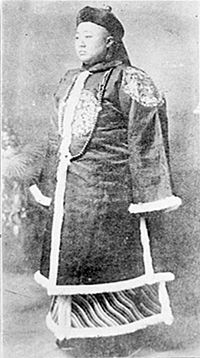

| Prince Zhuang of the First Rank | |||||||||
|---|---|---|---|---|---|---|---|---|---|
| Traditional Chinese | 和碩莊親王 | ||||||||
| Simplified Chinese | 和硕庄亲王 | ||||||||
| |||||||||
| Prince Chengze of the First Rank | |||||||||
| Traditional Chinese | 和碩承澤親王 | ||||||||
| Simplified Chinese | 和硕承泽亲王 | ||||||||
| |||||||||
Prince Zhuang of the First Rank (Manchu: ᡥᠣᡧᠣᡳ
ᠨᡤᠠᠮᠪᠠᠯᡳᠩᡤᡡ
ᠴᡳᠨ ᠸᠠᠩ; hošoi ambalinggū cin wang), or simply Prince Zhuang, was the title of a princely peerage used in China during the Manchu-led Qing dynasty (1644–1912). It was also one of the 12 "iron-cap" princely peerages in the Qing dynasty, which meant that the title could be passed down without being downgraded.
The first bearer of the title was Šose (1629–1655), the fifth son of Hong Taiji, the second ruler of the Qing dynasty. He was awarded the title Prince Chengze of the First Rank (Manchu: ᡥᠣᡧᠣᡳ
ᡴᡝᠰᡳᠨᡤᡤᡝ
ᠴᡳᠨ ᠸᠠᠩ; hošoi kesingge cin wang; Prince Chengze) in 1651 by his father. The peerage was renamed to "Prince Zhuang of the First Rank" when it was passed down to Šose's eldest son, Boguoduo (博果鐸; 1650–1723). In 1723, by decree of the Yongzheng Emperor, the emperor's 16th brother, Yunlu (1695–1767), inherited the Prince Zhuang peerage from Boguoduo because Boguoduo had no son to succeed him. During the reign of the Qianlong Emperor, the peerage was granted "iron-cap" status, which meant that the subsequent bearers of the title would start as a qinwang (first-rank prince) by default. The peerage was passed down over nine generations and held by 12 persons.
The title "Prince Zhuang of the First Rank" was also awarded in 1653 by the Shunzhi Emperor as a posthumous titletoŠurhaci (1564–1611), a younger brother of Nurhaci, the founder of the Qing dynasty.

| Family of Prince Zhuang | ||||||||||||||||||||||||||||||||||||||||||||||||||||||||||||||||||||||||||||||||||||||||||||||||||||||||||||||||||||||||||||||||||||||||||||||||||||||||||||||||||||||||||||||||||||||||||||||||||||||||||||||||||||||||||||||||||||||||||||||||||||||||||||||||||||||||||||||||||||||||||||||||||||||||||||||||||||||||||||||||||||||||||||||||||||||||||||||||||||||||||||||||||||||||||||||||||||||||||||||||||||||||||||||||||||||||||||||||||||||||||||||||||||||||||||||||||||||||||||||||||||||||||||||||||||||||||||||||||||||||||||||||||||||||||||||||||||||||||||||||||||||||||||||||||||||||||||||||||||||||||||||||||||||||||||||||||||||||||||||||||||||
|---|---|---|---|---|---|---|---|---|---|---|---|---|---|---|---|---|---|---|---|---|---|---|---|---|---|---|---|---|---|---|---|---|---|---|---|---|---|---|---|---|---|---|---|---|---|---|---|---|---|---|---|---|---|---|---|---|---|---|---|---|---|---|---|---|---|---|---|---|---|---|---|---|---|---|---|---|---|---|---|---|---|---|---|---|---|---|---|---|---|---|---|---|---|---|---|---|---|---|---|---|---|---|---|---|---|---|---|---|---|---|---|---|---|---|---|---|---|---|---|---|---|---|---|---|---|---|---|---|---|---|---|---|---|---|---|---|---|---|---|---|---|---|---|---|---|---|---|---|---|---|---|---|---|---|---|---|---|---|---|---|---|---|---|---|---|---|---|---|---|---|---|---|---|---|---|---|---|---|---|---|---|---|---|---|---|---|---|---|---|---|---|---|---|---|---|---|---|---|---|---|---|---|---|---|---|---|---|---|---|---|---|---|---|---|---|---|---|---|---|---|---|---|---|---|---|---|---|---|---|---|---|---|---|---|---|---|---|---|---|---|---|---|---|---|---|---|---|---|---|---|---|---|---|---|---|---|---|---|---|---|---|---|---|---|---|---|---|---|---|---|---|---|---|---|---|---|---|---|---|---|---|---|---|---|---|---|---|---|---|---|---|---|---|---|---|---|---|---|---|---|---|---|---|---|---|---|---|---|---|---|---|---|---|---|---|---|---|---|---|---|---|---|---|---|---|---|---|---|---|---|---|---|---|---|---|---|---|---|---|---|---|---|---|---|---|---|---|---|---|---|---|---|---|---|---|---|---|---|---|---|---|---|---|---|---|---|---|---|---|---|---|---|---|---|---|---|---|---|---|---|---|---|---|---|---|---|---|---|---|---|---|---|---|---|---|---|---|---|---|---|---|---|---|---|---|---|---|---|---|---|---|---|---|---|---|---|---|---|---|---|---|---|---|---|---|---|---|---|---|---|---|---|---|---|---|---|---|---|---|---|---|---|---|---|---|---|---|---|---|---|---|---|---|---|---|---|---|---|---|---|---|---|---|---|---|---|---|---|---|---|---|---|---|---|---|---|---|---|---|---|---|---|---|---|---|---|---|---|---|---|---|---|---|---|---|---|---|---|---|---|---|---|---|---|---|---|---|---|---|---|---|---|---|---|---|---|---|---|---|---|---|---|---|---|---|---|---|---|---|---|---|---|---|---|---|---|---|---|---|---|---|---|---|---|---|---|---|---|---|---|---|---|---|---|---|---|---|---|---|---|---|---|---|---|---|---|---|---|---|---|---|---|---|---|---|---|---|---|---|---|---|---|---|---|---|---|---|---|---|---|---|---|---|---|---|---|---|---|---|---|---|---|---|---|---|---|---|---|---|---|---|---|---|---|---|---|---|---|---|---|---|---|---|---|---|---|---|---|---|---|---|---|---|---|---|---|---|---|---|---|---|---|---|---|---|---|
| ||||||||||||||||||||||||||||||||||||||||||||||||||||||||||||||||||||||||||||||||||||||||||||||||||||||||||||||||||||||||||||||||||||||||||||||||||||||||||||||||||||||||||||||||||||||||||||||||||||||||||||||||||||||||||||||||||||||||||||||||||||||||||||||||||||||||||||||||||||||||||||||||||||||||||||||||||||||||||||||||||||||||||||||||||||||||||||||||||||||||||||||||||||||||||||||||||||||||||||||||||||||||||||||||||||||||||||||||||||||||||||||||||||||||||||||||||||||||||||||||||||||||||||||||||||||||||||||||||||||||||||||||||||||||||||||||||||||||||||||||||||||||||||||||||||||||||||||||||||||||||||||||||||||||||||||||||||||||||||||||||||||
{{cite book}}: CS1 maint: location missing publisher (link)|
| |
|---|---|
| Absorbed into the Crown |
|
| Non-downgrading peerages ("iron-cap" princes) |
|
| Demoted but non-downgrading peerages |
|
| Downgrading peerages |
|
| Posthumous titles |
|